Influence of B4C Particle Size on the Microstructure and Mechanical Properties of B4C/Al Composites Fabricated by Pressureless Infiltration
Abstract
1. Introduction
2. Experiments
3. Results and Discussion
3.1. Microstructure
3.2. Mechanical Properties at Room Temperature
3.3. High Temperature Compression Properties
4. Conclusions
Author Contributions
Funding
Data Availability Statement
Conflicts of Interest
References
- Fu, X.; Ji, Z.; Lin, W.; Yu, Y.; Wu, T. The advancement of neutron shielding materials for the storage of spent nuclear fuel. Sci. Technol. Nucl. Install. 2021, 2021, 5541047. [Google Scholar] [CrossRef]
- Zhang, P.; Li, Y.; Wang, W.; Gao, Z.; Wang, B. The design, fabrication and properties of B4C/Al neutron absorbers. J. Nucl. Mater. 2013, 437, 350–358. [Google Scholar] [CrossRef]
- Wu, C.; Li, Y.K.; Wan, C.L. Reactive-sintering B4C matrix composite for armor applications. Rare Met. 2020, 39, 529–544. [Google Scholar] [CrossRef]
- Ortiz, A.L.; Galán, C.A.; Borrero-López, O.; Guiberteau, F. Highly sliding-wear resistant B4C composites fabricated by spark-plasma sintering with Ti-Al additives. Scr. Mater. 2020, 177, 91–95. [Google Scholar] [CrossRef]
- Liu, Z.; Yu, J.; Wang, X.; Ma, P.; Gu, W.; Wen, J.; Wei, S.; Zhang, X.; Yan, Z.; Wen, T.; et al. Comparative study of B4C, Mg2B2O5, and ZrB2 powder additions on the mechanical properties, oxidation, and slag corrosion resistance of MgO-C refractories. Ceram. Int. 2022, 48, 14117–14126. [Google Scholar] [CrossRef]
- Chen, H.; Zeng, F.; Li, W.; Li, L.; Wang, Z.; Liu, H.; Peng, Y.; Gu, Y.; Zhang, F. Effect of interfacial residual thermal stress on the fracture behavior of Cf/B4C composites prepared by spark plasma sintering. Ceram. Int. 2020, 46, 4587–4594. [Google Scholar] [CrossRef]
- Shen, Y.; Li, G.; An, Q. Enhanced fracture toughness of boron carbide from microalloying and nanotwinning. Scr. Mater. 2019, 162, 306–310. [Google Scholar] [CrossRef]
- Lee, B.-S.; Kang, S. Low-temperature processing of B4C-Al composites via infiltration technique. Mater. Chem. Phys. 2001, 67, 249–255. [Google Scholar] [CrossRef]
- Mashhadi, M.; Taheri-Nassaj, E.; Sglavo, V.M.; Sarpoolaky, H.; Ehsani, N. Effect of Al addition on pressureless sintering of B4C. Ceram. Int. 2009, 35, 831–837. [Google Scholar] [CrossRef]
- Li, C.; Xia, X.; Cai, J.; Zhang, Z.; Wang, J.; Qian, Z.; Wang, X.; Dai, Y. Influence analysis of B4C content on the neutron shielding performance of B4C/Al. Radiat. Phys. Chem. 2023, 204, 110684. [Google Scholar] [CrossRef]
- Sivalingam, S.; Kumaresan, G.; Ganesh, P.; Azhagan, M.T. Superplastic Formability and Cavitation Analysis of AA7075 Matrix Composite Reinforced with B4C Particles Produced by Stir Casting. Int. J. Met. 2023, 1–11. [Google Scholar] [CrossRef]
- Brillon, A.; Garcia, J.; Riallant, F.; Garnier, C.; Joulain, A.; Lu, Y.; Silvain, J.-F. Characterization of Al/B4C composite materials fabricated by powder metallurgy process technique for nuclear applications. J. Nucl. Mater. 2022, 565, 153724. [Google Scholar] [CrossRef]
- Chao, Z.L.; Sun, T.T.; Jiang, L.T.; Zhou, Z.S.; Chen, G.Q.; Q.Z; Wu, G.H. Ballistic behavior and microstructure evolution of B4C/AA2024 composites. Ceram. Int. 2019, 45, 20539–20544. [Google Scholar] [CrossRef]
- Liu, B.; Huang, W.-M.; Wang, H.-W.; Wang, M.-L.; Li, X.-F. Compressive behavior of high particle content B4C/Al composite at elevated temperature. Trans. Nonferrous Met. Soc. China 2013, 23, 2826–2832. [Google Scholar] [CrossRef]
- Sree Manu, K.M.; Ajay Raag, L.; Rajan, T.P.D.; Gupta, M.; Pai, B.C. Liquid Metal Infiltration Processing of Metallic Composites: A Critical Review. Metall. Mater. Trans. B. Process Metall. Mater. Process. Sci. 2016, 47B, 2799–2819. [Google Scholar] [CrossRef]
- de Jongh, P.E.; Eggenhuisen, T.M. Melt Infiltration: An Emerging Technique for the Preparation of Novel Functional Nanostructured Materials. Adv. Mater. 2013, 25, 6672–6690. [Google Scholar] [CrossRef] [PubMed]
- Dong, Q.; Chen, L.; Zhao, M.; Bi, J. Synthesis of TiCp reinforced magnesium matrix composites by in situ reactive infiltration process. Mater. Lett. 2004, 58, 920–926. [Google Scholar] [CrossRef]
- Lin, Q.; Shen, P.; Qiu, F.; Zhang, D.; Jiang, Q. Wetting of polycrystalline B4C by molten Al at 1173–1473K. Scr. Mater. 2009, 60, 960–963. [Google Scholar] [CrossRef]
- Mei, Y.; Ju, B.; Yang, W.; Huang, F.; Wu, G. Microstructure Evolution of B4C/Al Interface: A First-Principle Study. J. Mater. Eng. Perform. 2021, 30, 9326–9332. [Google Scholar] [CrossRef]
- Zhou, L.; Cui, C.; Wang, Q.Z.; Li, C.; Xiao, B.L.; Ma, Z.Y. Constitutive equation and model validation for a 31vol.% B4Cp/6061Al composite during hot compression. J. Mater. Sci. Technol. 2018, 34, 1730–1738. [Google Scholar] [CrossRef]
- Li, Y.Z.; Wang, Q.Z.; Wang, W.G.; Xiao, B.L.; Ma, Z.Y. Interfacial reaction mechanism between matrix and reinforcement in B4C/6061Al composites. Mater. Chem. Phys. 2015, 154, 107–117. [Google Scholar] [CrossRef]
- Zhang, L.; Pang, S.; Gu, W.; Luo, K.; Tian, R.; Yang, H.; Jiang, Y.; Yang, Z. Interface regulation mechanism of Ti doping on B4C/Al composites. Ceram. Int. 2023, 49, 6113–6118. [Google Scholar] [CrossRef]
- Lai, J.; Zhang, Z.; Chen, X.G. Effect of Sc, Zr, and Ti on the interfacial reactions of the B4C/Al system. J. Mater. Sci. 2011, 46, 451–459. [Google Scholar] [CrossRef]
- Xu, G.; Yu, Y.; Zhang, Y.; Li, T.; Wang, T. Effect of B4C particle size on the mechanical properties of B4C reinforced aluminum matrix layered composite. Sci. Eng. Compos. Mater. 2019, 26, 53–61. [Google Scholar] [CrossRef]
- Zhang, L.; Shi, G.; Xu, K.; Hao, W.; Li, Q.; Junyan, W.; Wang, Z. Phase transformation and mechanical properties of B4C/Al composites. J. Mater. Res. Technol. 2020, 9, 2116–2126. [Google Scholar] [CrossRef]
- Wang, J.; Ren, D.; Chen, L.; Man, G.; Zhang, H.; Zhang, H.; Luo, L.; Li, W.; Pan, Y.; Gao, P.; et al. Initial investigation of B4C-TiB2 composites as neutron absorption material for nuclear reactors. J. Nucl. Mater. 2020, 539, 152275. [Google Scholar] [CrossRef]
- Chen, M.; Liu, Z. Ultrasound assisted casting method for fabricating B4Cp/Al composites with the addition of K2ZrF6. Mater. Lett. 2020, 280, 128545. [Google Scholar] [CrossRef]
- Ellert, T.; Frage, N. On the effects of particle size and preform porosity on the mechanical properties of reaction-bonded boron carbide infiltrated with Al-Si alloy at 950 °C. Ceram. Int. 2020, 46, 18994–18999. [Google Scholar] [CrossRef]
- Piňos, J. The information depth of backscattered electron imaging. J. Microsc. 2016, 266, 335–342. [Google Scholar] [CrossRef]
- Donovan, J.; Fellowes, J.; McMorran, B. Average Atomic Number and Electron Backscattering in Compounds. Microsc. Microanal. 2019, 25, 2314–2315. [Google Scholar] [CrossRef]
- Nie, J.; Liu, Y.; Wang, F.; Zhou, H.; Cao, Y.; Liu, X.; An, X.; Liao, X.; Zhu, Y.; Zhao, Y. Key roles of particles in grain refinement and material strengthening for an aluminum matrix composite. Mater. Sci. Eng. A 2021, 801, 140414. [Google Scholar] [CrossRef]
- Wei, W.; Zhang, Q.; Wu, W.; Cao, H.; Shen, J.; Fan, S.; Duan, X. Agglomeration-free nanoscale TiC reinforced titanium matrix composites achieved by in-situ laser additive manufacturing. Scr. Mater. 2020, 187, 310–316. [Google Scholar] [CrossRef]
- Yan, Y.-F.; Kou, S.-Q.; Yang, H.-Y.; Dong, B.-X.; Shu, S.-L.; Chen, L.-Y.; Qiu, F.; Zhang, L.-C. Manipulating interface bonding and microstructure via tuning interfacial reaction for enhancing mechanical property of in-situ TiC/Al cermets. J. Mater. Process. Technol. 2023, 317, 117995. [Google Scholar] [CrossRef]
- Deschamps, A.; Péron, S.; Bréchet, Y.; Ehrström, J.-C.; Poizat, L. High temperature cleavage fracture in 5383 aluminum alloy. Mater. Sci. Eng. A 2001, 319–321, 583–586. [Google Scholar] [CrossRef]
- Li, W.; Chen, H.; Li, C.; Huang, W.; Chen, J.; Zuo, L.; Ren, Y.; He, J.; Zhang, S. Microstructure and tensile properties of AISI 321 stainless steel with aluminizing and annealing treatment. Mater. Des. 2021, 205, 109729. [Google Scholar] [CrossRef]
- Konovalenko, I.; Maruschak, P.; Brezinová, J.; Brezina, J. Morphological characteristics of dimples of ductile fracture of VT23M titanium alloy and identification of dimples on fractograms of different scale. Materials 2019, 12, 2051. [Google Scholar] [CrossRef] [PubMed]
- Shin, S.; Lee, D.; Lee, Y.-H.; Ko, S.; Park, H.; Lee, S.-B.; Cho, S.; Kim, Y.; Lee, S.-K.; Jo, I. High Temperature Mechanical Properties and Wear Performance of B4C/Al7075 Metal Matrix Composites. Metals 2019, 9, 1108. [Google Scholar] [CrossRef]
- Fang, J.; Zhu, Z.; Zhang, X.; Xie, L.; Huang, Z. Tensile Deformation and Fracture Behavior of AA5052 Aluminum Alloy under Different Strain Rates. J. Mater. Eng. Perform. 2021, 30, 9403–9411. [Google Scholar] [CrossRef]
- Liu, Z.; Du, Z.; Jiang, H.; Zhao, X.; Gong, T.; Cui, X.; Cheng, J.; Liu, F.; Chen, W. Controlling the microstructure and fracture toughness of the Ti-5Al-5Mo-5V-1Cr-1Fe alloy by multiple heat treatments. J. Mater. Res. Technol. 2022, 17, 2528–2539. [Google Scholar] [CrossRef]
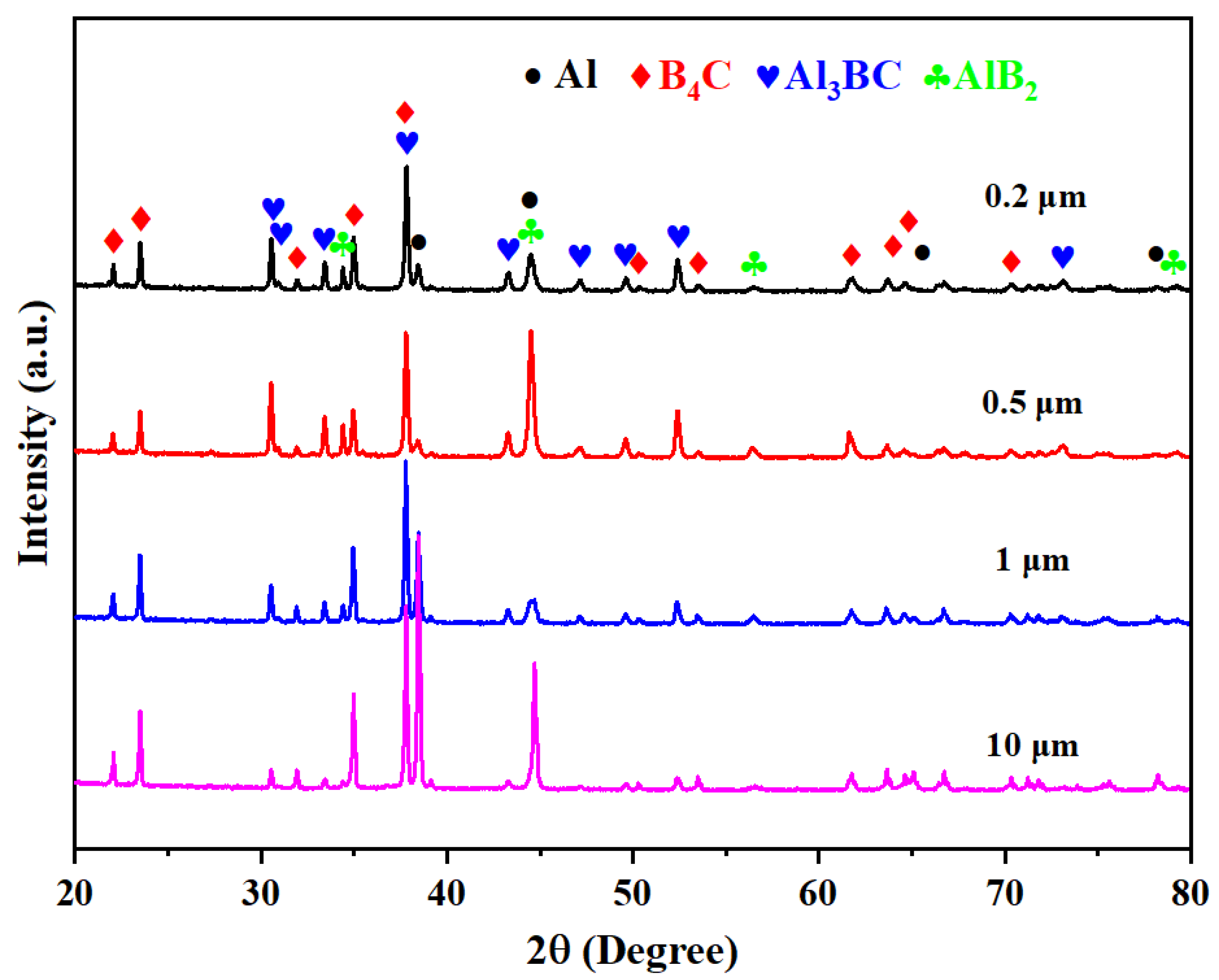
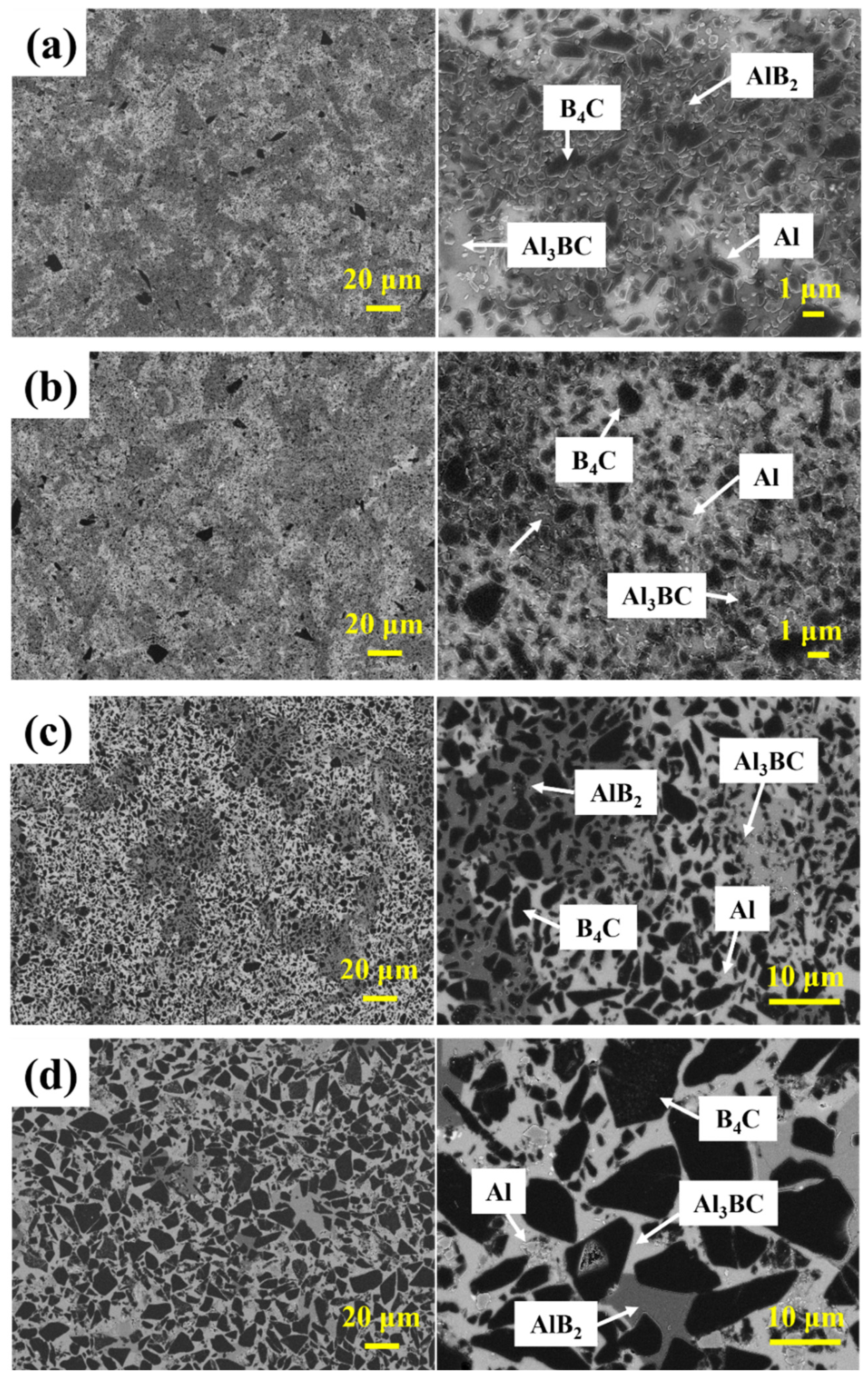


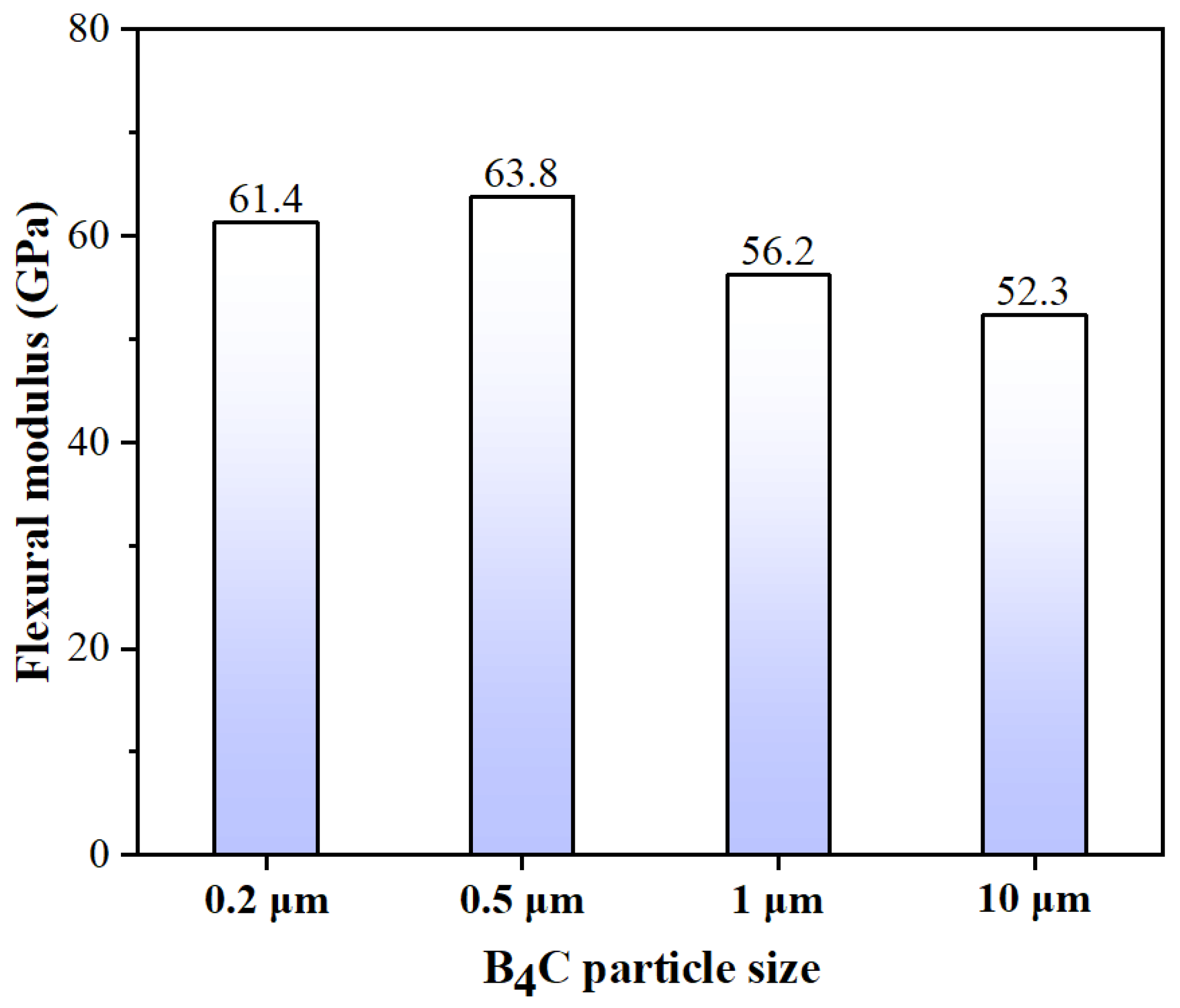
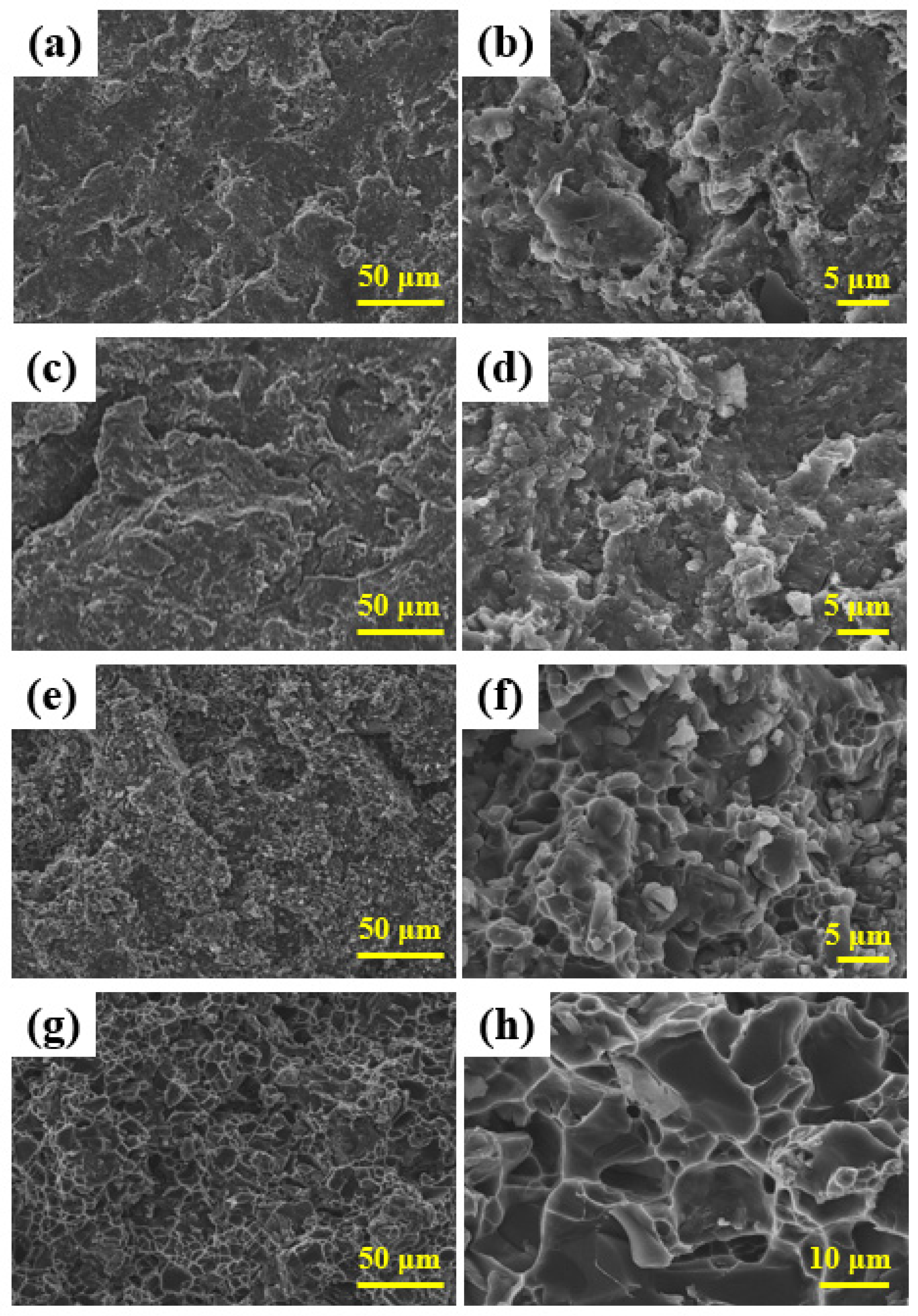
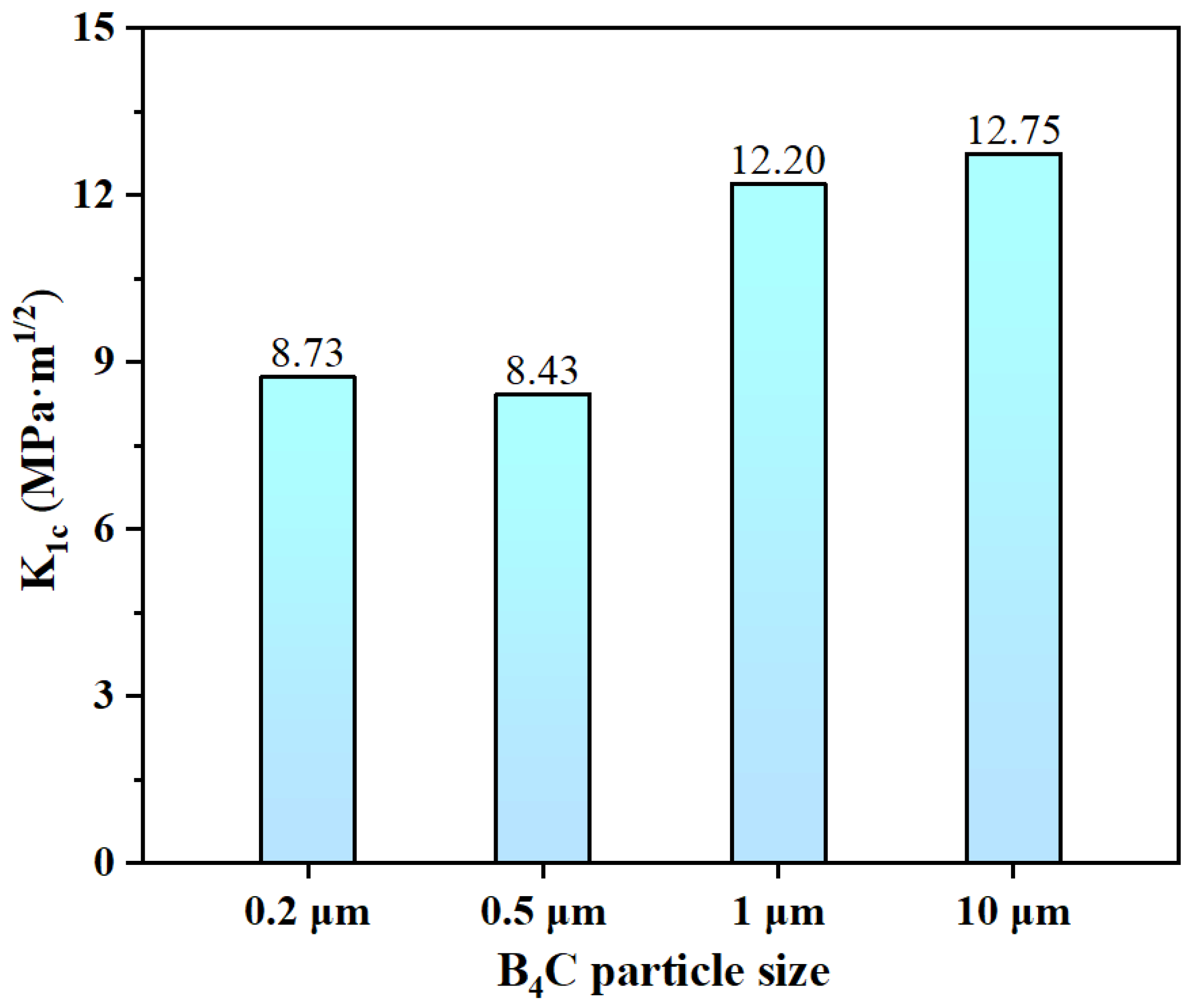
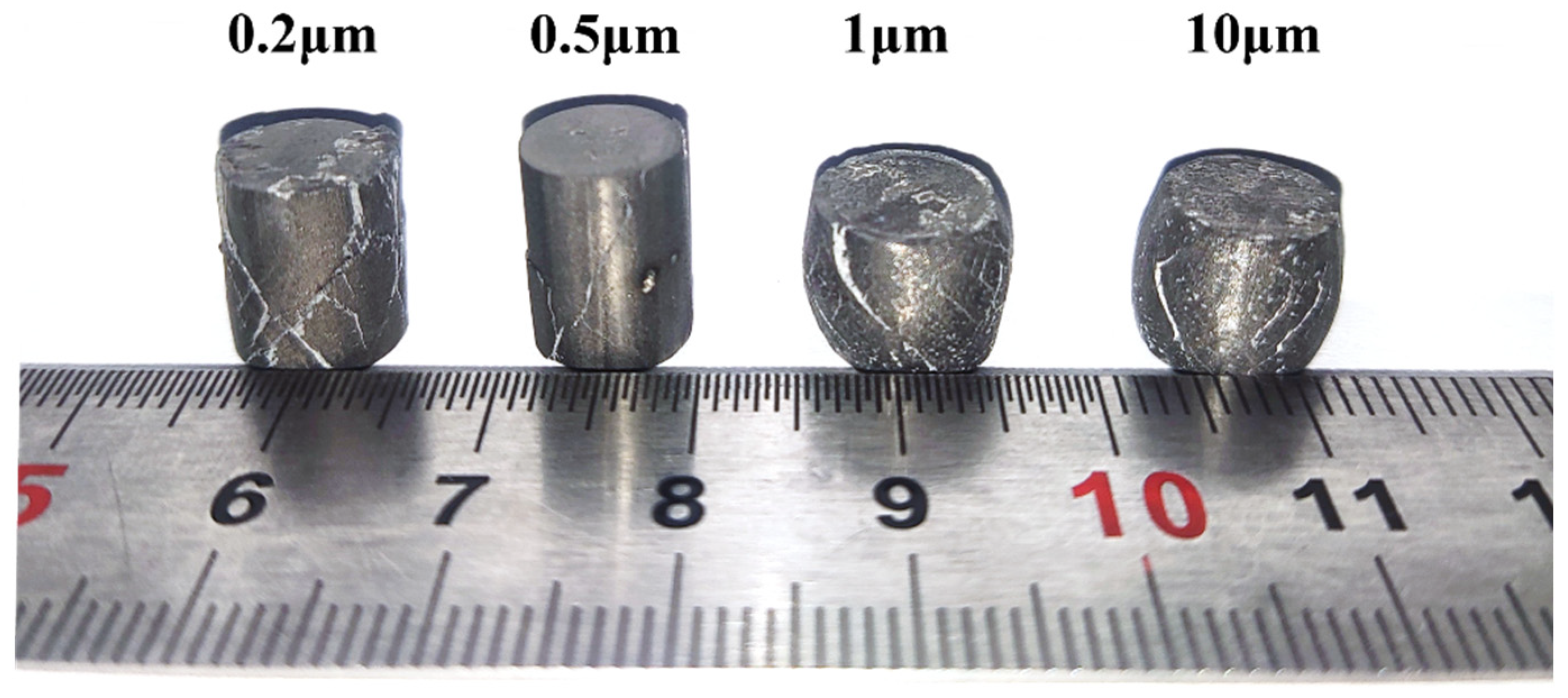

| B4C Particle Size (μm) | Actual Density (g/cm3) | Theoretical Density (g/cm3) | Relative Density |
|---|---|---|---|
| 0.2 | 2.555 | 2.601 | 0.982 |
| 0.5 | 2.555 | 2.602 | 0.982 |
| 1 | 2.577 | 2.600 | 0.991 |
| 10 | 2.552 | 2.599 | 0.982 |
Disclaimer/Publisher’s Note: The statements, opinions and data contained in all publications are solely those of the individual author(s) and contributor(s) and not of MDPI and/or the editor(s). MDPI and/or the editor(s) disclaim responsibility for any injury to people or property resulting from any ideas, methods, instructions or products referred to in the content. |
© 2023 by the authors. Licensee MDPI, Basel, Switzerland. This article is an open access article distributed under the terms and conditions of the Creative Commons Attribution (CC BY) license (https://creativecommons.org/licenses/by/4.0/).
Share and Cite
Liu, Y.; Peng, H.; Wei, L.; Peng, H.; Ma, D.; Leng, Y. Influence of B4C Particle Size on the Microstructure and Mechanical Properties of B4C/Al Composites Fabricated by Pressureless Infiltration. Metals 2023, 13, 1358. https://doi.org/10.3390/met13081358
Liu Y, Peng H, Wei L, Peng H, Ma D, Leng Y. Influence of B4C Particle Size on the Microstructure and Mechanical Properties of B4C/Al Composites Fabricated by Pressureless Infiltration. Metals. 2023; 13(8):1358. https://doi.org/10.3390/met13081358
Chicago/Turabian StyleLiu, Yao, Haokai Peng, Longjun Wei, Hao Peng, Donglin Ma, and Yongxiang Leng. 2023. "Influence of B4C Particle Size on the Microstructure and Mechanical Properties of B4C/Al Composites Fabricated by Pressureless Infiltration" Metals 13, no. 8: 1358. https://doi.org/10.3390/met13081358
APA StyleLiu, Y., Peng, H., Wei, L., Peng, H., Ma, D., & Leng, Y. (2023). Influence of B4C Particle Size on the Microstructure and Mechanical Properties of B4C/Al Composites Fabricated by Pressureless Infiltration. Metals, 13(8), 1358. https://doi.org/10.3390/met13081358







